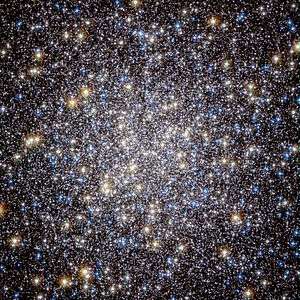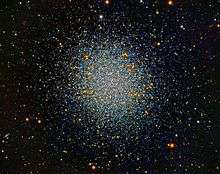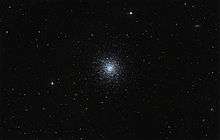Messier 13
| Messier 13 | |
|---|---|
 The heart of Hercules Globular Cluster Credit: ESA/Hubble and NASA | |
| Observation data (J2000 epoch) | |
| Class | V[1] |
| Constellation | Hercules |
| Right ascension | 16h 41m 41.24s[2] |
| Declination | +36° 27′ 35.5″[2] |
| Distance | 22.2 kly (6.8 kpc)[3] |
| Apparent magnitude (V) | +5.8[4] |
| Apparent dimensions (V) | 20 arcmins |
| Physical characteristics | |
| Mass | 6×105[5] M☉ |
| Radius | 84 ly[6] |
| Metallicity | = –1.33[7] dex |
| Estimated age | 11.65 Gyr[7] |
| Notable features | one of the best-known clusters of the northern hemisphere |
| Other designations | NGC 6205[4] |

Messier 13 (M13), also designated NGC 6205 and sometimes called the Great Globular Cluster in Hercules or the Hercules Globular Cluster, is a globular cluster of several hundred thousand stars in the constellation of Hercules.
Discovery and visibility
M13 was discovered by Edmond Halley in 1714, and cataloged by Charles Messier on June 1, 1764 into his list of objects not to mistake for comets; Messier's list, including Messier 13, eventually became known as the Messier Catalog.[8]
About a third of the way from Vega to Arcturus, four bright stars in the constellation of Hercules form the Keystone asterism. M13 can be seen partway between Zeta Herculis and Eta Herculis. Although only telescopes with great light-gathering capability fully resolve the stars of the Cluster, M13 can be visible to the naked eye depending on circumstances. With a low-power telescope, Messier 13 looks like a comet or fuzzy patch. The cluster is visible throughout the year from latitudes greater than 36 degrees north, with the longest visibility during northern hemisphere spring and summer.[9]
It is located at right ascension 16h 41.7m, declination +36° 28'. With an apparent magnitude of 5.8, it is barely visible with the naked eye on clear nights. Its diameter is about 23 arc minutes and it is readily viewable in small telescopes.[10] Nearby is NGC 6207, a 12th magnitude edge-on galaxy that lies 28 arc minutes directly northeast. A small galaxy, IC 4617, lies halfway between NGC 6207 and M13, north-northeast of the large globular cluster's center.
Traditional binoculars make the Hercules Globular Cluster look similar to a round patch of light. At least four inches of telescope aperture will allow observing the stars that constitute M13 as small pinpoints of light. However, only larger telescopes allow resolving stars further into the center of the cluster.[11]

Characteristics
M13 is about 145 light-years in diameter, and it is composed of several hundred thousand stars, the brightest of which is a red giant, the variable star V11, with an apparent visual magnitude of 11.95. M13 is about 22,200 light-years away from Earth.
It wasn't until 1779 that the single stars in this globular cluster were resolved. Compared to the stars in the neighborhood of the Sun, the stars in M13's stellar population are more than a hundred times denser. They are so densely packed together that they sometimes collide and produce new stars. The newly-formed, young stars, so-called "blue stragglers," are particularly interesting to astronomers.[12]
The Arecibo message of 1974, which contained encoded information about the human race, DNA, atomic numbers, Earth's position and other information, was beamed from the Arecibo Observatory radio telescope towards M13 as an experiment in contacting potential extraterrestrial civilizations in the cluster. The cluster will move through space during the transit time; opinions differ as to whether or not the cluster will be in a position to receive the message by the time it arrives.[13] [14]
Literary references
- The science fiction novellas "Sucker Bait" by Isaac Asimov and "Question and Answer" by Poul Anderson take place on Troas, a world within M13.
- In the science fiction series Perry Rhodan, M13 is the location of Arkon, the home world of the race of Arkonides.
- In author Dan Simmon's Hyperion Cantos the Hercules cluster is where a copy of Earth was secretly recreated after the original was destroyed.
- In The Sirens of Titan, Kurt Vonnegut writes "Every passing hour brings the Solar System forty-three thousand miles closer to Globular Cluster M13 in Hercules – and still there are some misfits who insist that there is no such thing as progress."
- Deliberately engineering a star in Messier 13 to go nova was part of the Cybermen’s complicated plot in the 1968 Doctor Who story The Wheel in Space.
- In Bill Amend's popular comic strip FoxTrot, Jason Fox mentions observing the M13 Globular Cluster.

See also
References
- ↑ Shapley, Harlow; Sawyer, Helen B. (August 1927), "A Classification of Globular Clusters", Harvard College Observatory Bulletin, 849 (849): 11–14, Bibcode:1927BHarO.849...11S.
- 1 2 Goldsbury, Ryan; et al. (December 2010), "The ACS Survey of Galactic Globular Clusters. X. New Determinations of Centers for 65 Clusters", The Astronomical Journal, 140 (6): 1830–1837, arXiv:1008.2755, Bibcode:2010AJ....140.1830G, doi:10.1088/0004-6256/140/6/1830.
- ↑ Paust, Nathaniel E. Q.; et al. (February 2010), "The ACS Survey of Galactic Globular Clusters. VIII. Effects of Environment on Globular Cluster Global Mass Functions", The Astronomical Journal, 139 (2): 476–491, Bibcode:2010AJ....139..476P, doi:10.1088/0004-6256/139/2/476.
- 1 2 "M 13". SIMBAD. Centre de données astronomiques de Strasbourg. Retrieved 2006-11-15.
- ↑ Leonard, Peter J. T.; Richer, Harvey B.; Fahlman, Gregory G. (1992), "The mass and stellar content of the globular cluster M13", Astronomical Journal, 104: 2104, Bibcode:1992AJ....104.2104L, doi:10.1086/116386.
- ↑ distance × sin( diameter_angle / 2 ) = 84 ly radius
- 1 2 Forbes, Duncan A.; Bridges, Terry (May 2010), "Accreted versus in situ Milky Way globular clusters", Monthly Notices of the Royal Astronomical Society, 404 (3): 1203–1214, arXiv:1001.4289, Bibcode:2010MNRAS.404.1203F, doi:10.1111/j.1365-2966.2010.16373.x.
- ↑ "Messier 13 (M13) - The Great Hercules Cluster - Universe Today". Universe Today. 2016-05-09. Retrieved 2018-04-23.
- ↑ "M13: Great Cluster in Hercules | EarthSky.org". earthsky.org. Retrieved 2018-03-26.
- ↑ "M 13". Messier Objects Mobile -- Charts, Maps & Photos. 2016-10-16. Retrieved 2018-04-23.
- ↑ "How to See the Great Hercules Cluster of Stars". Space.com. Retrieved 2018-04-23.
- ↑ Garner, Rob (2017-10-06). "Messier 13 (The Hercules Cluster)". NASA. Retrieved 2018-04-23.
- ↑ "It's the 25th anniversary of Earth's first attempt to phone E.T." 1999-11-12. Retrieved 2018-06-28.
- ↑ "Science 2.0". In regard to the email from. Retrieved 2015-04-15.
External links
| Wikimedia Commons has media related to Messier 13. |
- Messier 13, SEDS Messier pages
- Red Giant variable stars
- Messier 13, Galactic Globular Clusters Database page
- Messier 13, High-resolution LRGB image based on 2 hrs total exposure
- Messier 13, Amateur astrophotographer (hgg) photo using the 9.25" Celestron Telescope (85min exposure)
- M13 Hercules Globular photo detail Dark Atmospheres
- Variable Stars in M13. II.The Red Variables and the Globular Cluster Period-Luminosity Relation
- Messier 13, Image by Waid Observatory
- NightSkyInfo.com – M13, the Hercules Globular Cluster
- Photometric study of the V2 cepheid in M13
- Period, Amplitude and Light Curve of V38 in M13
- Great Globular Cluster in Hercules (Messier 13/NGC 6205)
- Rothery, David; Bauer, Amanda; Dhillon, Vik; Lawrence, Pete; Chapman, Allan; Fohring, Dora. "M13 – Hercules Globular Cluster". Deep Sky Video. Brady Haran.
- Messier 13 on WikiSky: DSS2, SDSS, GALEX, IRAS, Hydrogen α, X-Ray, Astrophoto, Sky Map, Articles and images
